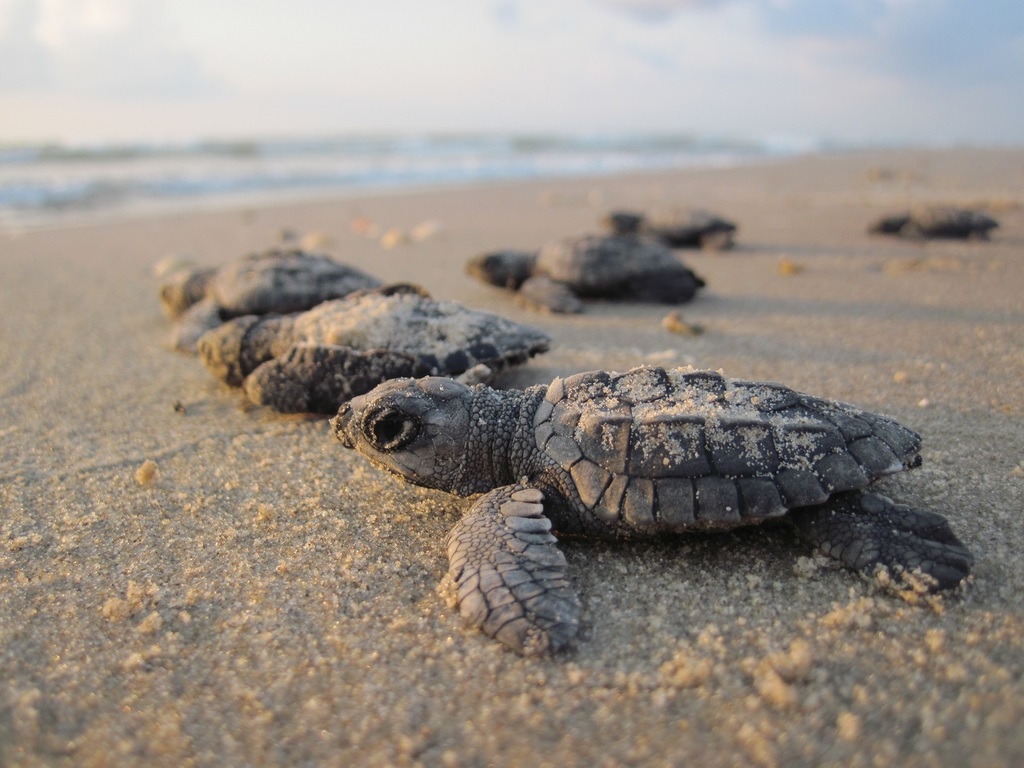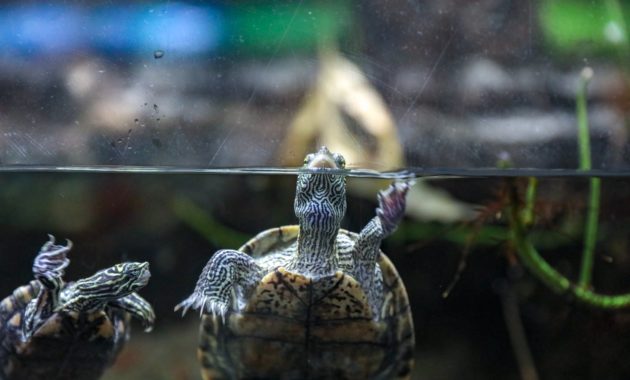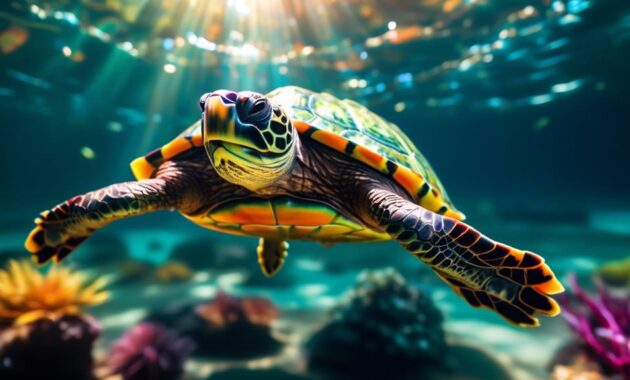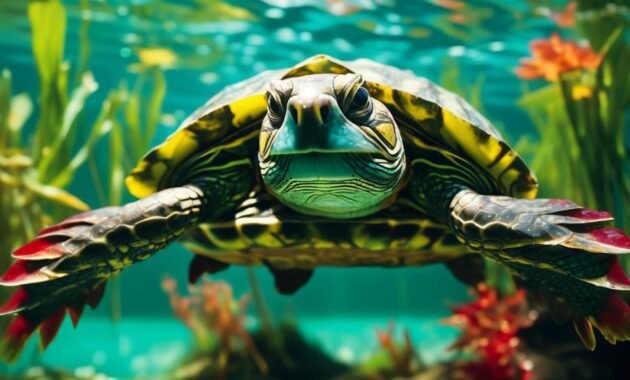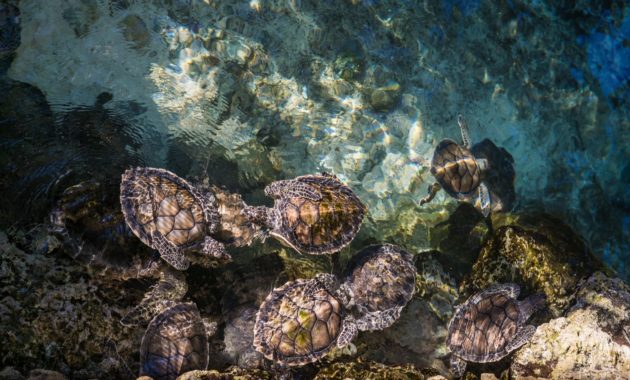
In miniature turtle care, the most critical issue is temperature.
The water in their habitat should be kept between 78 and 88 degrees Fahrenheit during the day; cooler at night.
This can be achieved by using a submersible aquarium heater or other methods that do not introduce additional heat into the tank.
A thermometer will help you monitor the temperature to ensure it remains stable 24 hours a day.
Temperature is also essential for air-breathing reptiles like turtles who spend some time out of the water, such as basking in UVB light or eating fresh fruit and vegetables from a plate on land.
Air temperatures should stay pretty constant throughout the day (between 60 and 85 degrees). Turtles are cold-blooded animals, so they cannot regulate their body heat as we do.
As turtles are hibernating animals, the longer and colder the winter is, the more they will need to be exposed to air temperatures above freezing as well as UVB light and food with high levels of nutrients.
1. What miniature aquatic turtles are
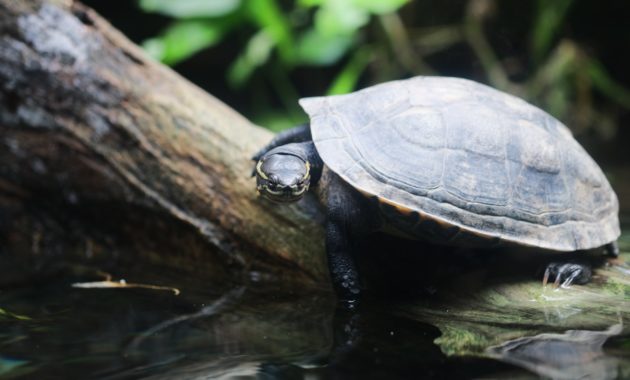
Miniature Turtles are tiny miniature turtles that only reach a maximum of 8 inches.
They have a reduced number of scales, and they do not grow to be significant in size.
Miniature aquatic turtles are more accessible to take care of than larger marine creatures because their requirements are less intense.
This is why miniature aquatic turtles are popular for those who want to own a pet but do not have the time for a giant pet that requires more care or space where they live.
2. How to take care of miniature aquatic turtles
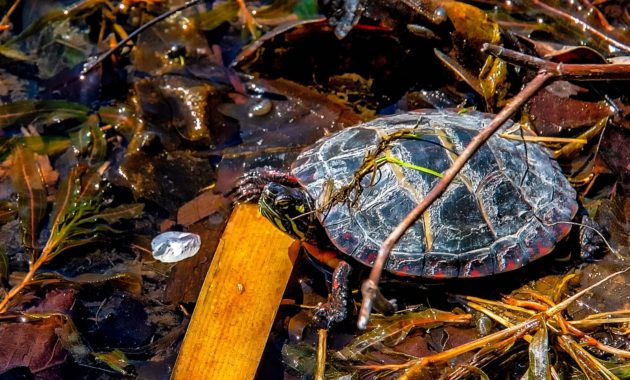
Miniature turtles need the same level of care as any other type of pet, but they’re small enough that you don’t have to spend as much time geon neral maintenance.
1) Be sure to provide your miniature aquatic turtles with an appropriately sized enclosure that can house them comfortably and offers plenty of room for them to swim.
If there is another turtle or animal in the household, make sure to introduce them slowly.
2) You should always provide your miniature aquatic turtles with an appropriate diet.
They need a varied and balanced diet that includes a variety of fruit and vegetables in addition to meat products.
Make sure not to feed them anything toxic!
3) Be sure to clean their habitat every day so that it is free of waste, germs and pollutants.
You can do this by siphoning the tank or using a miniature aquatic turtle filter.
4) Monitor the miniature aquatic turtle’s health by checking its shell and skin for any rashes or injuries.
If you see something that looks out of the ordinary or something that is getting worse, take your miniature aquatic turtle to a qualified miniature aquatic turtle veterinarian.
5) If the miniature aquatic turtle is sick, be sure to observe it closely so that you can tell what’s wrong with it and if it’s something that you can treat at home or if it needs immediate veterinary attention.
3. The benefits of miniature aquatic turtles
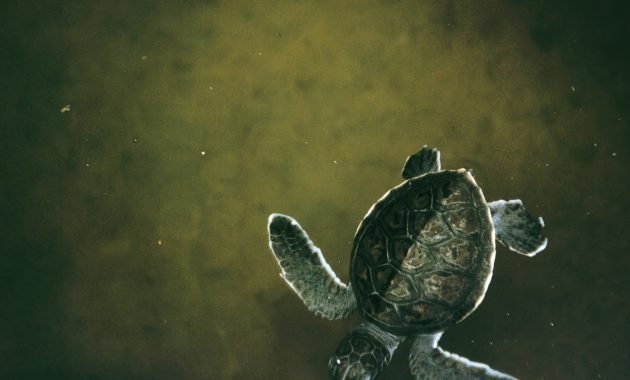
1) miniature aquatic turtles are easy to take care of, and this makes them a popular choice for those who don’t have a lot of time but still want to own a pet.
2) miniature aquatic turtles require much less space than other types of pets, and they don’t need as much upkeep.
3) miniature turtles are relatively low-maintenance, so you can enjoy your pet without having to spend a lot of time taking care of it.
4) miniature turtles are very cute, and you can show them off as pets to your friends. There is always a chance that they will want to own miniature turtles too!
4. Tips on choosing the right miniature aquatic turtle for you
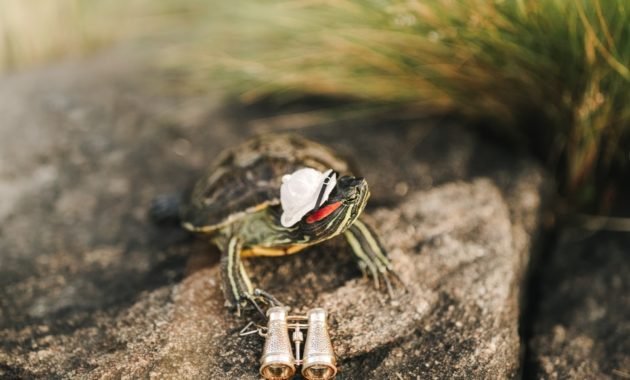
There are many miniature aquatic turtle species to choose from, depending on what you are looking for.
Some people like a hardy and easy to keep in captivity, while others like the look of a specific colour or shell pattern.
If you’re looking for a good starter turtle, you may want to research the following:
1) American Cooters and Sliders are both very hardy turtles that will do well even without much care in captivity.
2) Red-eared sliders are larger than cooters (about 7 inches long) and have a bright red stripe across their faces just above their eyes.
3) Spotted turtles have dark black spots all over their shells and heads; they grow about 5 inches long.
4) Painted turtles have dark stripes on their shells and red or yellow spots, mostly on their legs. They can grow up to about 12 inches long.
If you like miniature aquatic turtle species that stay small, do well in captivity, and are colourful or unusual looking, consider the following:
a.) Mexican Slider
This miniature aquatic turtle species (also called a red-eared slider) is very small when it’s young and grows to about 7 inches in length.
It has a dark stripe on its face that resembles an earring, hence the name.
The shell color of this miniature aquatic turtle changes as the turtle ages; the hatchlings have yellowish-brown shells, olive-green shells as they become adults, and finally dark reddish-brown shells when they become adults.
They make great starter turtles or pets for people with limited space or time to care for one.
b.) Painted turtle
This miniature aquatic turtle species (also called a red-eared slider) is very small when it’s young and grows to about 7 inches in length.
It has a dark stripe on its face that resembles an earring, hence the name. The shell color of this miniature aquatic turtle changes as the turtle ages; the hatchlings have yellowish-brown shells, olive-green shells as they become adults, and finally dark reddish-brown shells when they become adults.
They make great starter turtles or pets for people with limited space or time to care for one.
c.) Eastern Box Turtles
This miniature aquatic turtle species (also called a red-eared slider) is very small when it’s young and grows to about 7 inches in length.
It has a dark stripe on its face that resembles an earring, hence the name. The shell colour of this miniature aquatic turtle changes as the turtle ages.
The hatchlings have yellowish-brown shells, olive-green shells as they become adults, and, finally, dark reddish-brown shells when they become adults.
They make great starter turtles or pets for people with limited space or time to care for one.
5. Mistakes to avoid when caring for miniature aquatic turtles
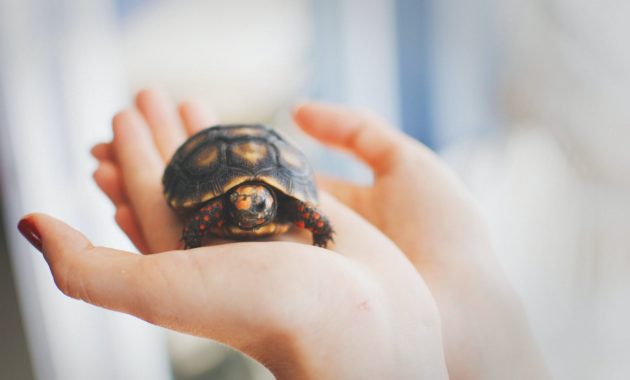
the common mistake to avoid when caring for natural aquatic turtles is not performing regular water changes.
The tank should be cleaned often and they can also be given a fresh new environment.
The miniature aquatic turtle can’t escape from their surroundings, so an ammonia buildup is more likely to occur in these types of situations.
Doing a water change will help and will also keep the miniature aquatic turtle healthy.
Aquatic turtles, miniature or not need to have proper lighting requirements so that they can grow at a normal pace.
They should be exposed regularly to natural light.
Full-spectrum lighting is great for miniature aquatic turtles as well as other types of turtles but fluorescent lighting is recommended for miniature aquatic turtles.
The miniature aquatic turtle that is housed indoors should be exposed to natural sunlight as much as possible.
If the miniature aquatic turtle cannot be exposed to real sunlight, then it should be given adequate artificial light such as full-spectrum lights or fluorescent lights.
The brightness of the lighting and how often it is changed depends entirely on the miniature aquatic turtle.
Safe plants for miniature aquatic turtles are also very important and these include water hyacinth, Amazon sword plant and anubias type ferns.
The miniature aquatic turtle can be introduced to live food once they reach a certain size.
They usually feed upon algae but they can also be fed dead food such as crickets.
One should be cautious when feeding miniature aquatic turtles because they can choke on the food.
6. How miniature aquatic turtle care is similar to that of other reptiles
Egg-laying miniature aquatic turtles, such as red-eared sliders and painted turtles, are just like other reptiles in the sense that they require a specific set of care.
The miniature aquatic turtles require a temperature of between 75 and 80 degrees Fahrenheit.
This particular miniature turtle requires a lot of light, so it is best to use fluorescent lights or natural sunlight in order to maintain this temperature.
As miniature aquatic turtles are semi-aquatic, one needs to be careful with the humidity because these miniature turtles can easily get dehydrated due to their inability to move in the water.
Removing the substrate from the bottom of their habitat provides more humidity for miniature aquatic turtles requiring this higher humidity level while also providing better flow for water at the bottom of their habitat.
When miniature aquatic turtles are kept in captivity, it is vital to remember that these miniature turtles can carry salmonella, which owners must be careful with to avoid sickness.
A miniature turtle owner should contact a veterinarian if the turtle shows any signs of illness.
If miniature turtle owners follow proper steps for breeding miniature aquatic turtles, miniature turtles should live between 20 and 50 years.
They must maintain proper hygiene and health of miniature aquatic turtles to ensure they can breed miniature aquatic turtles.
7. How miniature aquatic turtle care is different from that of other reptiles
Miniature aquatic turtles are different in that they are nocturnal creatures.
This means that miniature aquatic turtles do not like to be exposed to natural light because they can seriously stress the miniature aquatic turtle.
Miniature aquatic turtles also prefer an aquarium with a lot of water and swamp plants so that the miniature aquatic turtle will feel at home.
The miniature aquatic turtle requires a lot of protein to grow normally, so it is important for miniature aquatic turtle owners to feed the miniature aquatic turtles a diet that contains plenty of proteins.
Another thing miniature aquatic turtle owners should consider when taking care of miniature aquatic turtles is that they are very fragile creatures, and any type of stress can be extremely harmful to the miniature aquatic turtle.
Miniature aquatic turtles can be fed a varied diet consisting of fruits and vegetables like lettuce, apples, oranges, leafy greens, etcetera, and live invertebrates like crickets, earthworms, mealworms and even small fish.
Other food items that miniature aquatic turtles should be feed include pellets and aquatic turtle food pellets.
8. Conclusion
If you are looking for a low maintenance pet, loves to be handled and won’t take up too much space in your home, then miniature aquatic turtles may be the perfect animal.
These little guys have been gaining popularity with reptile lovers because they’re easy to care for without sacrificing any of the fun features!
They can live in small environments such as fish tanks or bowls so don’t worry about having enough room.
Many different species are available, like red-eared sliders and painted turtles which will keep things interesting if one becomes more popular.
To set up their habitat correctly, provide them with shallow water at least 2 inches deep.
This should allow their head (and nose) to break through the surface.
They love to sunbathe, so a basking platform is also recommended.

